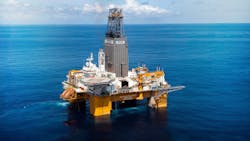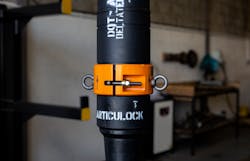OTC 2023: Former DeltaTek CEO highlights South Africa drilling tech case study
By Ariana Hurtado, Editor and Director of Special Reports
HOUSTON — During the "Drilling Technology, Operations and Case Studies" technical session on May 2 at OTC, former DeltaTek CEO and Founder Tristam Horn, who is now Expro's senior product line manager following the acquisition of DeltaTek, reviewed the "Deepwater Operator Saves Multiple Days of Riserless Drilling Operations Using Novel Articulation Tool" whitepaper, authored by Expro and TotalEnergies.
In the case study, a new articulation tool is used by deepwater operator TotalEnergies to address the significant riserless drilling operations risks associated with extreme environmental conditions off the coast of southeastern tip of South Africa.
The Luiperd prospect, which sits in 1,760 m (5774 ft) of water, faces strong surface currents and harsh weather throughout the year.
These extreme environmental conditions required careful planning for open water operations to mitigate the associated risks for rig equipment potentially exceeding maximum bending moments or reaching fatigue life limits, among other concerns," the paper states.
For the previously operated offset well, TotalEnergies used drift running techniques during riserless drilling to deploy casing and drilling assemblies in open water to limit its exposure time to strong surface currents. Horn explained that this application of the technique in single derrick mode resulted in safe but slow and costly drilling.
For the Luiperd well, one of the measures taken by TotalEnergies to mitigate environmental risks was the use of Expro's ArticuLock articulation tool to reduce the bending stresses applied to the subsea wellhead running tools and landing string while running the conductor pipe and the surface casing. "This articulation tool is based on a ball-and-socket concept, which provides zero rotational stiffness up to 15 degrees in any direction while exceeding operational requirements for through-torque, tensile and working pressure ratings," according to the paper.
The Luiperd well was successfully drilled during third-quarter 2020 using Odfjell Drilling's Deepsea Stavanger mobile offshore drilling unit (MODU). During the well's riserless drilling operations two of the articulation tools were applied, one being made up just above the subsea wellhead running tools and another being placed within the drillpipe landing string in the MODU's moon pool.
Early stages
Results
Because the articulation tool effectively eliminated the highest bending moments that would otherwise act upon the landing string and wellhead running tools, it de-coupled the MODU from the conductor and surface casings run on the Auxiliary Well Center, enabling dual derrick operations that were not possible for the offset well, the authors of the paper explained.
The use of this technology saved multiple drift runs and more than 10 days of rig time for the Luiperd well compared with the 2014 offset.
"TotalEnergies had a lot of confidence to take it to this Luiperd application," Horn said during his presentation. "And the technology was used both on the conductor pipe and on the surface casing. On the surface casing, we have over two meters per second of current actually measured with over five meters of significant wave height. And the technology had nearly three days of suspension time with over 300 metric tons through it."
A maximum 317 MT (700,000 lb) of surface casing and landing string was suspended beneath the upper articulation tool. Both articulation tools were in continuous use for 75 hours with 4.3 knots of current and up to 5 m (16 ft) significant wave height (Hs).
"Although the Luiperd well was drilled in a unique offshore environment, similar conditions are prevalent across the world's deepwater basins, including the West of Shetland area in the UK and in the Gulf of Mexico where loop currents present a regular challenge," the paper states. "The subject Novel Articulation Tool can reduce operational risks and provide step change improvements in drilling performance for wells, which need to contend with strong surface currents and harsh weather environments."
Horn also noted that the team learned that the external sleeve wasn't able to actually fit through the bend restrictor in its original configuration, and the protector plates were damaged as a result. So, a redesign of a fully removable clamp sleeve was included in the subsequent runs, which has been the way that the technology has been run ever since.
"I'd like to thank the TotalEnergies petroleum team for using the technology [and] the Odfjell Drilling team," Horn said, concluding his presentation.
Recent news
TotalEnergies and its co-venturers in Block 11B/12B offshore South Africa applied for a production right in late March. According to partner Africa Energy, they are considering either an early production system or a phased development of their two deepwater gas-condensate discoveries.
The early production system on the Luiperd discovery would accelerate the Block 11B/12B development timeline through using infrastructure on the adjacent block to supply gas to customers in Mossel Bay. It would also substantially reduce the capex to delivering first production on the block.
Africa Energy anticipates a full development of the Paddavissie Fairway would follow the early production system as the gas market expands in South Africa. Analysis of 2D and 3D seismic data has identified further prospectivity both in the fairway and to the east, reinforcing the view of large exploration upside across the block.
Africa Energy President and CEO Garrett Soden said the company expected operator TotalEnergies to finalize the development concept and gas offtake terms this year before receiving the production right approval in early 2024.
05.04.2023
About the Author
Ariana Hurtado
Editor-in-Chief
With more than a decade of copy editing, project management and journalism experience, Ariana Hurtado is a seasoned managing editor born and raised in the energy capital of the world—Houston, Texas. She currently serves as editor-in-chief of Offshore, overseeing the editorial team, its content and the brand's growth from a digital perspective.
Utilizing her editorial expertise, she manages digital media for the Offshore team. She also helps create and oversee new special industry reports and revolutionizes existing supplements, while also contributing content to Offshore's magazine, newsletters and website as a copy editor and writer.
Prior to her current role, she served as Offshore's editor and director of special reports from April 2022 to December 2024. Before joining Offshore, she served as senior managing editor of publications with Hart Energy. Prior to her nearly nine years with Hart, she worked on the copy desk as a news editor at the Houston Chronicle.
She graduated magna cum laude with a bachelor's degree in journalism from the University of Houston.



